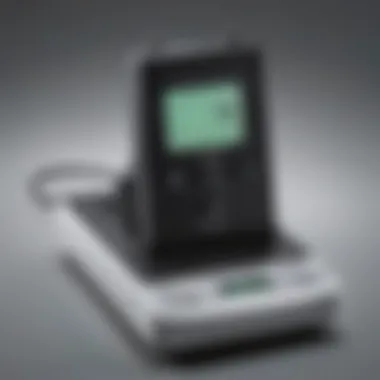Exploring the Corning pH Meter 440: Features and Benefits


Research Background
Overview of the Scientific Problem Addressed
In scientific research, precise measurements of pH levels are critical across various disciplines, from environmental science to pharmaceuticals. Accurate pH readings influence experimental outcomes, product development, and safety assessments. For these reasons, reliable pH meters are indispensable tools. The Corning pH Meter 440 stands as a solution to these challenges, promising consistency and accuracy.
Historical Context and Previous Studies
Historically, pH measurement relied on less accurate methods, such as litmus paper or simple probes. These techniques provided limited precision and sometimes misleading results. Over time, advancements in technology led to electronic pH meters, which offered better accuracy but often at a higher complexity. Previous studies demonstrated significant variations in measurement reliability, prompting the need for a device that combined ease of use with advanced technology.
The Corning pH Meter 440 emerged in response to these demands, integrating scientific expertise with user needs.
Findings and Discussion
Key Results of the Research
The Corning pH Meter 440 is distinguished by its accuracy and functionality. User evaluations have shown that it provides consistent readings even in challenging conditions. The device features a large LCD display that makes it easy to read results, enhancing usability during experiments. Users noted its robustness in the calibration process, typically requiring only two-point calibration for high precision.
Users benefit from a straightforward interface, reducing the learning curve for new users while maintaining advanced features sought by professionals. Advanced sensors also contribute to faster response times, essential for dynamic experiments.
Interpretation of the Findings
The findings affirm that the Corning pH Meter 440 is not only effective but also critical in enhancing research accuracy. Researchers reported fewer errors in their experiments, leading to more reliable data collection. This improvement can lead to better-informed decisions in both research and practical applications.
Preface to pH Measurement
pH measurement is a crucial aspect of laboratory science. It reflects the acidity or alkalinity of a solution, which is vital in various experiments and processes. Understanding pH affects chemical reactions and biological systems. This section will outline the significance of pH and its applications in scientific disciplines.
Understanding pH and its Importance
The term "pH" refers to the potential of hydrogen, a scale that ranges from 0 to 14. A pH of 7 indicates neutrality, while values below 7 denote acidity, and values above 7 indicate alkalinity. The measurement of pH is important for several reasons:
- Chemical Reactions: Many chemical reactions are pH-dependent. The rate and efficiency can vary significantly based on the pH level of the solution.
- Biological Processes: In biology, pH plays a role in enzyme activity. The proper pH range ensures optimal conditions for biochemical reactions.
- Environmental Studies: Monitoring the pH of water bodies helps assess the health of ecosystems. It can indicate pollution or changes in water chemistry that affect aquatic life.
Therefore, measuring pH not only aids in understanding fundamental scientific principles but also has real-world applications that impact health, environment, and industry.
Applications of pH Measurement in Science
pH measurement is integral to multiple scientific fields. Its applications span laboratory research, environmental monitoring, and industrial processes. Some notable applications include:
- Chemistry Laboratories: Here, pH measurements are essential for synthesizing chemicals, preparing buffers, and controlling reactions.
- Biotechnology: In biotechnology, maintaining specific pH levels is crucial for fermentation processes and cell culture growth.
- Agriculture: pH affects nutrient availability in soils. Farmers measure soil pH to optimize crop production.
- Pharmaceuticals: In drug formulation, pH can influence the stability and solubility of compounds.
- Water Quality Testing: Regular pH testing in water treatment plants ensures safe drinking water standards are met.
In summary, the relevance of pH measurement is evident across various scientific domains. Its role is vital in promoting safety, enhancing research outcomes, and fostering innovation.
Overview of the Corning pH Meter
The Corning pH Meter 440 stands as a relevant tool for accurate pH measurement in various settings. Its design, functionality, and ease of use make it a critical asset for laboratories, field studies, and industrial applications. This section explores the device's design and build quality, as well as its technical specifications. Each aspect contributes to understanding how the meter can enhance research and data analysis effectively.
Design and Build Quality
The design of the Corning pH Meter 440 is user-centric, emphasizing practicality and durability. It features a robust casing and a well-organized interface. This ensures that it can withstand the rigors of frequent handling in lab environments or fieldwork. The layout of the buttons is intuitive, catering to both novice and experienced users alike.
In addition, the device ensures comfort during operation, as it fits well in the hand, allowing for ease of measurement in various positions. The screen is designed to be visible under different lighting conditions, reducing strain during long usage periods.


Technical Specifications
pH Range
The pH range of the Corning pH Meter 440 extends from 0 to 14, making it suitable for a wide variety of samples. This extensive range allows users to measure very acidic solutions to highly alkaline ones. Such versatility makes it a beneficial choice for a range of applications.
One significant characteristic of this range is its ability to provide accurate readings in extreme conditions. This feature is especially advantageous in research scenarios where precision is paramount. Using the meter, researchers can analyze complex samples with confidence.
Accuracy
Accuracy is a defining feature of the Corning pH Meter 440. With a sensitivity of ±0.01 pH units, it is designed for high-level precision. This level of accuracy enhances the reliability of the readings, crucial for scientific data interpretation.
The ability to achieve this degree of accuracy is significant for users engaged in various analytical activities. It minimizes errors, directly impacting the quality of data produced. Therefore, it is a popular choice for laboratories where results must be confirmed repeatedly.
Display Features
The display features of the Corning pH Meter 440 contribute further to its usability. It comes with a backlit LCD screen that displays readings clearly. This aids in reducing reading errors even in dim lighting situations.
A unique feature of the display is its capacity to show multiple data points simultaneously. Users can view the pH level alongside other relevant parameters. This function is particularly valuable in complex testing scenarios, where multiple factors must be assessed concurrently.
"The clarity of display is crucial, especially when conducting critical measurements in various environments."
In summation, the design and technical specifications of the Corning pH Meter 440 highlight its role as a vital instrument in scientific research. Its outstanding pH range, unmatched accuracy, and effective display features make this meter a preferred choice.
Key Features of the Corning pH Meter
The Corning pH Meter 440 is distinguished by its thoughtful design and technological advancements. While many meters exist in the marketplace, its specific features cater to the needs of researchers and professionals who seek accuracy and ease of use. This section will delve into the various attributes that make the Corning pH Meter 440 a valuable instrument for pH measurement.
User Interface and Navigation
A clean and intuitive user interface is critical for effective operation of the Corning pH Meter 440. The device's display is designed to provide clear and concise readings. Users can easily navigate through different settings using well-placed buttons, minimizing the learning curve for new users. Functions are logically organized, allowing quick access to calibration settings, measurement history, and data logging options. This streamlined approach is essential in a laboratory where time efficiency is key.
Calibration Functionality
Calibration is a vital aspect of ensuring precision in any pH measurement device. The Corning pH Meter 440 offers a straightforward calibration process. Users can choose from standard buffer solutions to calibrate their device accurately. The meter supports multi-point calibration, enhancing accuracy over a wider pH range. Regular calibration is essential to maintain reliability. Users should do this frequently, especially in settings where pH readings are critical. Proper understanding of this functionality can significantly affect the validity of results.
Data Logging Capabilities
The data logging feature of the Corning pH Meter 440 is particularly noteworthy. It enables users to record measurements over time, which is invaluable for trend analysis. Data can be logged automatically or manually, depending on user preference. The device often provides options to export data for further analysis, allowing integration with other software tools. This capability not only enhances efficiency but also supports thorough documentation, which is crucial in scientific environments.
Using robust data logging features allows researchers to keep a comprehensive track of their measurements, optimizing both workflow and accuracy.
In this section, we've highlighted the key features of the Corning pH Meter 440. The interface, calibration aspects, and data logging capabilities significantly contribute to its position as a trusted device within various scientific domains. These attributes work together to elevate the user experience, ensuring effective pH measurement in both laboratory and field applications.
Operational Guidelines for the Corning pH Meter
The operational guidelines for the Corning pH Meter 440 are essential. They ensure users can maximize the instrument's potential. Proper use influences the accuracy of pH measurements, the longevity of the device, and the overall data reliability. Understanding these guidelines helps maintain consistent performance over time. They also aid new users in quickly adapting to the device, fostering confidence in their pH measurement skills.
Initial Setup and Configuration
Setting up the Corning pH Meter 440 is straightforward but vital for optimal performance. Initially, users should ensure the correct power source is available. Connect the meter and check that all components are intact. Next, users should assemble the electrode properly with the main unit. This connection is critical for accurate readings.
Once set up, the device must be turned on. The display will guide users through the initial configuration steps. This typically includes selecting language preferences and date settings. It's wise to follow the user manual carefully during this stage to avoid errors. A correct setup lays the foundation for accurate pH readings in subsequent measurements.


Calibration Process Detailed
Calibration is necessary to ensure the accuracy of pH readings. The process involves adjusting the meter to align with known standards. This segment contains detailed aspects of calibration procedures.
Standard Buffer Solutions
Standard buffer solutions play a crucial role in the calibration process. These solutions have known pH values, providing a reliable reference point. Using them is a standard practice because they allow for precise adjustments. A key characteristic of these solutions is their stability, which helps ensure readings remain consistent.
A unique feature of standard buffer solutions is their availability in various pH levels. This variety allows users to calibrate the meter across a wider range, enhancing its versatility. While beneficial, one must also be aware of the potential downsides. The solutions can degrade over time, so users should avoid using expired buffers to ensure accuracy.
Frequency of Calibration
Frequency of calibration is significant for maintaining accuracy. Regular calibration is recommended, especially if the device is used frequently or in varying environmental conditions. A noteworthy aspect is that it ensures the pH readings remain reliable and reduces drift.
The unique feature of adhering to a consistent calibration schedule strengthens the integrity of the data collected. Users often find that calibrating after prolonged use can prevent issues with measurement reliability. However, over-calibrating can lead to wear on the electrode, an aspect to consider for long-term use.
Conducting pH Measurements
Conducting pH measurements correctly is vital for acquiring valid data. This section covers the essential steps and considerations during the measuring process.
Sample Preparation
Sample preparation is a crucial step. Ensuring the sample is homogeneous and at the correct temperature enhances measurement accuracy. The key characteristic lies in preparing the sample to mimic the conditions expected during measurement. This practice reduces errors during the pH analysis.
A unique feature of good sample preparation is the ability to reduce contaminants that may alter pH levels. Users should avoid introducing foreign substances to ensure the integrity of the readings. However, one must also consider that improper preparation can lead to misleading results, which is a risk that should not be taken lightly.
Measurement Procedure
The measurement procedure is the culmination of setup and preparation. It involves submerging the electrode in the sample and allowing the meter to record a stable reading. A key characteristic of this procedure is its reliance on patience. Users must wait for the reading to stabilize before recording values.
A unique feature of the measurement procedure is the ability to obtain results quickly. However, quick measures without proper stabilization checking can lead to inaccurate data. This inconsistency is a common drawback when haste is involved in pH measurements.
Applications of the Corning pH Meter
The Corning pH Meter 440 is a versatile instrument essential for a wide range of applications. Understanding where and how this device can be used is important to appreciate its value in scientific research and industrial applications. The precision of pH measurements is critical in many fields, from agriculture to pharmaceuticals. This section covers the diverse applications of the Corning pH Meter 440, shedding light on its importance and benefits in different settings.
Laboratory Use Cases
In laboratory environments, the Corning pH Meter 440 provides reliable and accurate pH readings that are crucial for experiments.
- Biochemical Research: Maintaining optimal pH levels is vital in biochemical experiments, especially those involving enzyme activity. Researchers rely on precise measurements to ensure reactions occur at expected pH values.
- Environmental Testing: Laboratories often conduct tests on soil and water samples. The Corning pH Meter 440 facilitates the analysis of acidity and alkalinity in these samples, helping to assess environmental health and compliance with safety standards.
- Quality Control and Assurance: In production environments, monitoring pH helps to maintain product quality. For example, in food and beverage industries, pH can influence taste, preservation, and safety. Using the Corning pH Meter 440 ensures that products meet regulatory requirements.
Field Applications
Field applications demand portability and accuracy, which the Corning pH Meter 440 provides.
- Agriculture: Farmers use pH meters to test soil acidity, which affects nutrient availability. Understanding pH levels enables better fertilizer application and crop selection.
- Water Quality Monitoring: Environmental scientists often measure the pH of natural water bodies to monitor ecological health. The Corning pH Meter 440’s portability makes it suitable for on-site assessments, giving immediate results and insights into water quality issues.
- Field Research: Researchers working in natural habitats can rely on this device to quickly measure pH on-site, allowing them to gather data that influences conservation strategies.
Industrial Relevance
Various industries leverage the Corning pH Meter 440 for its precision and reliability.
- Chemical Manufacturing: In chemical processes, maintaining specific pH levels is crucial. This meter enables real-time monitoring, reducing the likelihood of product failure or hazardous situations.
- Pharmaceuticals: The pharmaceutical industry requires rigorous testing for pH levels during drug formulation. The Corning pH Meter 440 helps ensure that active ingredients function as intended, supporting product efficacy and safety.
- Waste Management: For industries involved in waste treatment, pH monitoring is essential to ensure compliance with environmental regulations. The pH Meter 440 assists in maintaining safe pH levels during waste disposal processes.


Understanding the applications of the Corning pH Meter 440 illustrates its adaptability across fields, highlighting its critical role in research, environmental health, and industrial processes.
Maintenance and Care of the Corning pH Meter
Maintaining and caring for the Corning pH Meter 440 is crucial for its optimal performance and longevity. Regular maintenance not only ensures accuracy in readings but also minimizes the potential for damage to the device. By establishing a consistent care routine, users can enhance the reliability of their measurements and, in turn, support their research and experiments effectively.
Cleaning the Electrode
The electrode is a vital component of the Corning pH Meter 440, and its cleanliness directly affects measurement accuracy. Over time, contaminants can build up on the electrode surface, leading to erroneous readings. It is essential to clean the electrode regularly, especially after using it in different sample types. To clean the electrode:
- Rinse the electrode with distilled or deionized water.
- For stubborn residues, use a soft brush or cloth to gently scrub the surface.
- Soak the electrode in a suitable cleaning solution if necessary, such as a mild detergent or specific electrode cleaning solutions recommended by Corning.
- Rinse thoroughly again to remove any cleaning residue.
Letting the electrode dry completely before storing will help maintain its integrity.
Storage Recommendations
Proper storage of the Corning pH Meter 440 is critical for its performance. The electrode should never be allowed to dry out, as this can lead to damage. Store the meter in a safe, cool place to avoid extreme temperatures. Here are some key storage steps:
- Keep the electrode moist: Place the electrode in a storage solution designed for pH meters, or simply store it in a small amount of potassium chloride solution.
- Avoid direct sunlight: Prolonged exposure to sunlight can degrade the electrode and other components of the meter.
- Use protective caps: Always put the protective cap back on when the meter is not in use to keep the electrode safe from contaminants.
Troubleshooting Common Issues
Even with regular maintenance and care, users may encounter certain issues with the Corning pH Meter 440. Being aware of these common problems and their solutions can save time and ensure consistent results. Here are some typical issues:
- Inconsistent readings: This can be caused by a dirty electrode or improper calibration. Clean the electrode and repeat the calibration procedure using standard buffer solutions.
- Slow response time: This may indicate that the electrode is drying out. Ensure the electrode is properly stored in a suitable solution.
- Error messages on display: If the meter shows an error message, refer to the user manual for specific troubleshooting steps. Common causes include calibration errors or issues with the connection of the electrode.
Maintaining and caring for the Corning pH Meter 440 not only enhances the accuracy of measurements but also prolongs the life of the device. By following recommended cleaning and storage practices, and being prepared to troubleshoot common issues, users can ensure that their pH measurement experience is both effective and reliable.
Comparative Analysis with Other pH Meters
Understanding how the Corning pH Meter 440 stacks up against other pH meters in the market is essential for informed choices. This section aims to highlight the unique features of the Corning pH Meter 440 in comparison with similar devices.
Similar Devices in the Market
In the highly competitive field of pH measurement, several devices are notable competitors to the Corning pH Meter 440. Some of these include:
- Hanna Instruments HI 98107: This portable meter is known for its economic price point, making it popular among casual users.
- Oakton pH 5+: Features a robust design and is recognized for its accuracy, especially in laboratory settings.
- Milwaukee MW102: Offers a dual-scale LCD and is praised for its ease of use.
Each of these alternatives comes with its own set of strengths and weaknesses. While some may offer lower prices or more portable options, they often sacrifice accuracy or durability compared to the Corning pH Meter 440.
Advantages of the Corning pH Meter
The Corning pH Meter 440 distinguishes itself with several advantages that enhance its value in both laboratory and field applications:
- Accuracy: It provides exceptionally precise measurements, greatly benefiting research that relies on precise pH levels.
- User-Friendly Interface: The intuitive design makes it accessible for a range of users, from students to experienced researchers. This reduces the learning curve often associated with complex devices.
- Durability: Built to withstand rigorous use, this meter is reliable in environments where other devices may fail.
- Versatile Calibration: The calibration process is straightforward, allowing for accurate readings across various sample types, which is a crucial aspect for experimental consistency.
"Precision in measurement is not just a luxury but a necessity in scientific research. The Corning pH Meter 440 fulfills this need effectively."
End
In this article, the significance of understanding the Corning pH Meter 440 has been thoroughly explored. The emphasis on both its technical specifications and user-friendly features highlights its relevance in modern laboratory settings. Accurate pH measurement is crucial for many scientific pursuits, from research to quality control in industrial applications. This article provides valuable insights for students, researchers, educators, and professionals alike.
Summary of Key Points
- Design and Build Quality: The Corning pH Meter 440 combines durability with functionality, ensuring it remains effective over time.
- Technical Specifications: With a wide pH range and high accuracy, this device stands out in the market.
- Calibration Functionality: The ease of calibration makes this meter accessible for both novices and experts.
- Applications: Suitable for various environments, from labs to fieldwork, enhancing its versatility.
- Maintenance Requirements: Simple care routines ensure longevity and reliability of the pH meter.
- Comparative Advantages: Its advantages over similar devices reinforce its place as a preferred option in pH measurement.
These points summarize the core discussions presented throughout the article, emphasizing how the Corning pH Meter 440 fulfills vital roles in various scientific domains.
Final Thoughts on Adoption in Research
As scientific research continues to evolve, tools like the Corning pH Meter 440 bring significant benefits. Researchers require precise measurements to validate their findings. The integration of automatic calibration and data logging features allowed by this meter enhances the accuracy of collected data. Furthermore, its user-friendly interface ensures that even those with limited experience can operate it efficiently.







